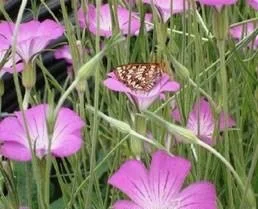Nectar Plants for Butterflies
A garden fluttering with butterflies is one of the great joys of late summer, so much so that growing nectar plants can be a reason in itself to garden!
Some adult butterflies are very specific about what they eat but many will feed from a wide variety of flowers. Plant floral nectar sources to attract masses of butterflies, while at the same time providing food to fuel the long journeys of migrating species.
Butterflies have varying lifecycles and habits. Swallowtails, Azures, and Skippers, for example, often have three generations a year, with the final generation spending the dormant season in a chrysalis. Monarchs have four or even five generations a year; the last one to emerge migrates to Mexico. Painted Ladies reproduce throughout their migration periods; a round-trip journey from Mexico to Canada and back takes six generations! As adults, most butterflies live only 7 to 10 days. Their job is simple: to mate and lay eggs. A few are longer lived, notably those that migrate and a few types that hibernate as adults rather than pupae.
Planting flowers that bloom from spring through fall will provide nectar for adult butterflies as they emerge from chrysalises, and for others as they pass though on their migratory journeys. In addition to sugar and water, nectar provides nutrients such as amino acids, proteins, enzymes, and vitamins.
Spring blooming plants are important to migrating butterflies, such as Monarchs and Painted Ladies, as they make their way northward. Swallowtails, Mourning Cloaks and all the other species that shelter in place for the winter as chrysalises or adults appreciate early sources of nectar also.
Chives, Dianthus, Larkspur, Agrostemma, Calendula, and other early bloomers provide nectar for butterflies as they emerge in spring, or after a long journey. Spring blooming plants are important for pollinators as well!
Plants with multiple florets contain copious amounts of nectar.
Sunflower, Heliotrope, French Marigolds, and Forget-me-nots have multiple florets, with nectar easily accessible to butterflies.
Plants with large, flat petals make it easy for large butterflies to land.
Tithonia, Zinnia, Cosmos, Rudbeckia, Coneflower, and other daisy-like flowers have easy landing platforms for butterflies. They’re long blooming and colorful, and easy to grow from seed.
Tubular shaped flowers are also attractive to butterflies. A straw-like sucking organ called a proboscis allows them to extract the nectar.
Tall Verbena, annual Milkweed (Asclepias), and Salvias of all kinds offer tubular blooms, and plenty of nectar for butterflies.
















